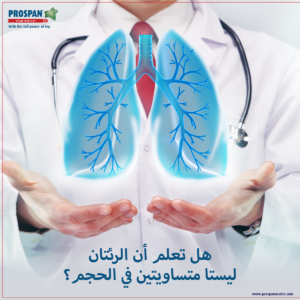
What we all know about the respiratory system is that it is responsible for providing the body with oxygen and getting rid of carbon dioxide.
This body consists of a group of members, including Lungs, trachea, diaphragm, and alveoli.
The surprising and interesting things that we do not know about it are:
- We Lose a lot of water through the breathing process
Breathing enables us to supply the cells with the oxygen you need and get rid of carbon dioxide residues. The process of exhalation also works to get rid of a large amount of water, which is equivalent to 17.5 ml of water within an hour, and of course, the amount increases greatly during our exercise.
- Some people can hold their breath for more than 20 minutes
An adult can hold their breath for 30 to 60 seconds, and it is difficult to exceed this limit, not only because of a lack of oxygen, but the biggest factor is the accumulation of acidic carbon dioxide in the blood, which our bodies store in myoglobin; It is a protein found in muscle tissue.
However, divers who practice diving in the water without using equipment (free diving) possess various techniques such as hyperventilation; Which works to reduce the concentration of carbon dioxide levels in the blood, and thus allow them to hold their breath for long periods. The Danish Stig Severinsen succeeded in entering the Guinness Book of World Records for the longest free diving operation, as he was able to hold his breath for 22 minutes.
- The lung is distinguished as the only organ that can float above water
Each of our lungs contains 300 million alveoli, which are similar to balloons in their shapes, and which work to replace the waste carbon dioxide in our blood with oxygen. When these structures are filled with air, the lung becomes the only organ that can float above the surface of the water!
In fact, medical examiners use the so-called “lung float test” during autopsies to determine if a baby was stillborn (died in the womb). If the lungs float, the baby was born alive; if the lungs don’t float, the baby was stillborn. This method is accurate 98 percent of the time, according to a 2013 study in the International Journal of Legal Medicine.
- Sneezing spray does not travel as fast as we think
Over the years, several studies have been conducted on sneezing speed, and the results recorded varied. In 2013, one study demonstrated that the maximum speed of sneezing is lower than that previously determined, where a high-speed camera and LED light were used to measure this, and the result was that the maximum speed of sneezing of study participants is 16 km / h.
- The lungs and trachea are important symbols of ancient Egypt
The lungs and trachea work side by side to supply the body’s tissues and cells with the oxygen they need, and this applies to the human body and animals. Realizing the importance of this cohesion, the ancient Egyptians designed a hieroglyphics that depict the lungs attached to the trachea, to symbolize the unity between Upper and Lower Egypt. Given that the Pharaohs ruled both Upper and Lower Egypt at that time, the hieroglyphic writing of the lungs and reeds was often found on the artifacts of these pharaohs, including their clothing, furniture, and jewelry.
- The movement of the chest during breathing is not caused by the movement of the air
Our chest is enlarged when we inhale the air, and it shrinks during the exhalation process, but this has nothing to do with the air entering or leaving the lungs. The explanation behind these chest movements is that the diaphragm shrinks during the inhalation process, which increases the area of the chest cavity. At the same time, the muscles contract between the ribs to pull the rib cage up and out. The exact opposite occurs during the exhalation process.
- In the old days, asthma was treated with psychotherapy
Modern science has shown that asthma is a chronic lung disease that causes the airways to become inflamed and narrowed. It’s a physical illness that can be exacerbated by psychological factors. In the period between the thirties and fifties of the twentieth century, it was believed among people that asthma is due to psychological reasons, Therefore, treatments for asthma focused mainly on psychoanalysis. A noteworthy example is the fact that some therapists interpreted a child’s asthma as a cry for his mother.
- Pulmonary circulation got its first description in the thirteenth century
Pulmonary circulation is the process of transferring blood from the heart to the lungs and again to the heart, to supply the heart with the oxygen the blood carries from the lungs. The famous Arab physician Ibn al-Nafis was the first to find a description of this complex process in 1243, and he explained it in detail in his book “Commentary on Anatomy in Avicenna’s Canon.”, while European scientists needed another 300 years to reach the same conclusion.
